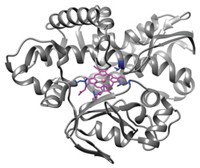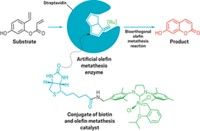Advertisement
Grab your lab coat. Let's get started
Welcome!
Welcome!
Create an account below to get 6 C&EN articles per month, receive newsletters and more - all free.
It seems this is your first time logging in online. Please enter the following information to continue.
As an ACS member you automatically get access to this site. All we need is few more details to create your reading experience.
Not you? Sign in with a different account.
Not you? Sign in with a different account.
ERROR 1
ERROR 1
ERROR 2
ERROR 2
ERROR 2
ERROR 2
ERROR 2
Password and Confirm password must match.
If you have an ACS member number, please enter it here so we can link this account to your membership. (optional)
ERROR 2
ACS values your privacy. By submitting your information, you are gaining access to C&EN and subscribing to our weekly newsletter. We use the information you provide to make your reading experience better, and we will never sell your data to third party members.
Synthesis
Organometallic Catalyst Works With Natural Enzymes In Reaction Cascades
Artificial metalloenzyme made of iridium complex embedded in protein scaffold cooperates with natural enzymes
by Celia Henry Arnaud
December 3, 2012
| A version of this story appeared in
Volume 90, Issue 49

Transition-metal catalysts and biological catalysts don’t always play nicely. In fact, like playground bullies, they can be downright mean, shutting each other down. But now, an international team of chemists has found a way to make them friends. Making organometallic catalysts and enzymes compatible with one another could expand the range of reactions available for industrial biotechnology, such as the production of new types of biofuels.
The team—Thomas R. Ward of the University of Basel, in Switzerland; Nicholas J. Turner of the University of Manchester, in England; and Frank Hollmann of Delft University of Technology, in the Netherlands; and coworkers—has developed an artificial metalloenzyme that works in reaction cascades with multiple natural enzymes (Nat. Chem., DOI: 10.1038/nchem.1498).
This combination has been tough to achieve. “For many years, biocatalysts and organometallic catalysts have been developed separately,” says Yi Lu, a chemistry professor at the University of Illinois, Urbana-Champaign. “Although much effort has been devoted to combining the two fields, the incompatibility between the two types of catalysts has made it difficult to realize the promise, particularly in carrying out cascade reactions like those observed in biology.” The new work shows that an artificial metalloenzyme containing an organometallic center is “not only compatible with native enzymes but can also work in harmony with them to perform several cascade reactions,” Lu says.
The researchers made an artificial transfer hydrogenase by embedding an iridium catalyst in a streptavidin scaffold. The streptavidin pocket protects the catalyst and prevents it from inactivating enzymes. “We’re keeping systems that are ‘allergic’ to each other apart,” Ward says.
The researchers used genetic engineering to improve the metalloenzyme. “The organometallic catalyst alone is already active in the absence of any enzyme that inhibits it,” Ward says. “When inserted in streptavidin, the artificial metalloenzyme becomes compatible with a variety of natural enzymes. Thanks to genetic engineering coupled with a colorimetric assay, we also significantly improved the performance of the artificial metalloenzyme.”
The researchers used the artificial transfer hydrogenase in reaction cascades with several other enzymes. For instance, they coupled it with a monoamine oxidase to catalyze the double stereoselective deracemization of amines. In addition, they made a four-enzyme cascade to synthesize
“The authors have shown how molecular compartmentalization of organometallic catalysts can increase the efficiency of biocatalytic cascades and enable new cascades,” says Claudia Schmidt-Dannert, a biologist at the University of Minnesota, Twin Cities. “This work is just at the beginning of how protein scaffolds can be engineered and fitted with completely unnatural cofactors designed in the chemistry lab to perform novel types of enzyme reactions.”





Join the conversation
Contact the reporter
Submit a Letter to the Editor for publication
Engage with us on Twitter